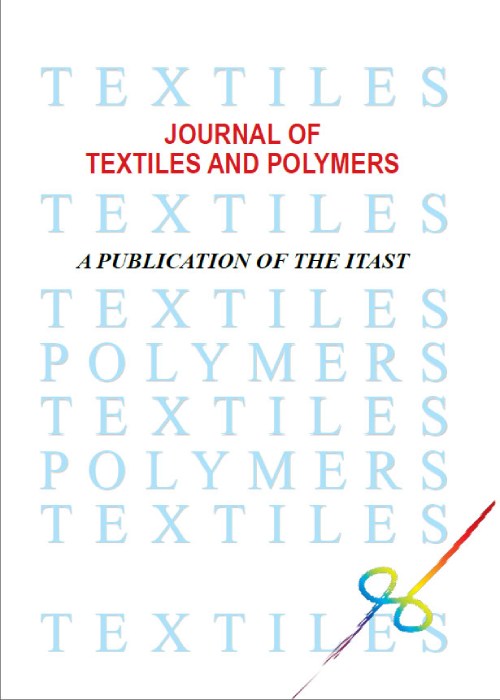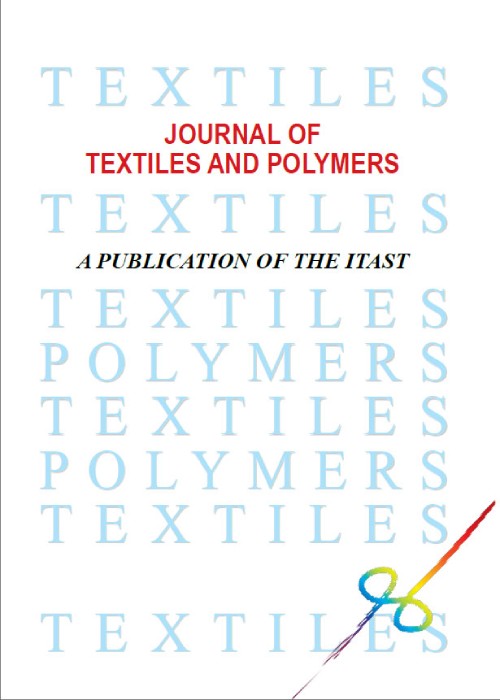فهرست مطالب

Journal of Textiles and Polymers
Volume:11 Issue: 1, Winter 2023
- تاریخ انتشار: 1402/03/28
- تعداد عناوین: 6
-
-
صفحات 3-12تغییرات و تحولات سریع بازارها و پیچیدگی و بی نظمی محیط بازار و شرایط اقتصاد حاکم بر کشور به واسطه تحریم ها، ضرورت توجه به رویکرد شکست ناپذیری در صنایع را پدیدار ساخته است. صنعت نساجی یکی از صنایع راهبردی بوده که به واسطه بازار بزرگ مصرف داخلی باید موردتوجه قرار گیرد و پادشکننده شود. صنایع مختلف نساجی با پادشکننده شدن می توانند به سرعت خود را با شرایط جدید انطباق دهند و در یک شرایط امن و پایدار، ارزش رقابتی خود را حفظ نمایند و حتی ارتقاء دهند. پژوهش حاضر با مروری بر ادبیات موضوعی به منظور پادشکنندگی صنایع نساجی در طول زنجیره تامین صورت پذیرفت. به این صورت که ابتدا مولفه های پادشکنندگی شناسایی و با استفاده از تکنیک بروز مدل بهترین_بدترین در شرایط عدم قطعیت وزن دهی شدند. سپس با مرور ادبیات صنعت نساجی و مصاحبه با خبرگان این صنعت، عوامل استرس زا شناسایی شد و با استفاده از روش تاپسیس مورد ارزیابی قرار گرفت تا مهم ترین عوامل مخل پادشکنندگی شناسایی و رتبه بندی شود. درنهایت، نتایج حاصل از پژوهش نشان داد که مولفه های: غیرمنتظره بودن، ناظرین کافی و افزونگی مهم ترین مولفه-ها هستند. همچنین نتایج به دست آمده از روش تاپسیس نشان داد عدم دسترسی به سرمایه خارجی و بازار های صادراتی اصلی، فرسودگی ماشین آلات صنعت زنجیره ریسندگی و واردات پوشاک از کشور های تولید کننده ارزان قیمت، دارای بیشترین اهمیت در زنجیره تامین صنعت نساجی می باشند.کلیدواژگان: پادشکنندگی زنجیره تامین، صنعت نساجی، نظریه شکستناپذیری، بهترین-بدترین فازی، تاپسیس
-
Pages 3-12The rapid changes and transformations of the markets and the complexity and disorder of the market environment and the conditions of the economic situation in the country due to the sanctions have made it necessary to pay attention to anti- fragility approach in the industries. The textile industry is one of the strategic industries that should be considered and rewarded due to the large domestic consumption market. Various textile industries can quickly adapt to new conditions and maintain and even improve their competitive value in a safe and stable condition. The current research was conducted with a review of the literature in order to achieve anti-fragility of textile industries throughout the supply chain. In this way, the anti- fragility components were first identified and weighed using the updated best-worst model technique under conditions of uncertainty. Then, by reviewing the literature of the textile industry and interviewing the experts of this industry, stressful factors were identified and evaluated using the TOPSIS method in order to identify and rank the most important factors that disrupt anti-fragility. Finally, the results of the research showed that the components: unexpectedness, sufficient supervisors and redundancy are the most important components. Also, the results obtained from the TOPSIS method showed that the lack of access to foreign capital and the main export markets, the wear and tear of the machinery of the spinning chain industry, and the import of clothing from low-cost producing countries are the most important in the supply chain of the textile industry.Keywords: Supply Chain anti- fragility, textile industry, Anti-fragility theory, Fuzzy BWM, TOPSIS
-
Pages 13-26In this study, gelatin-hydroxyapatite (GEL/HA) composites as biological organic-inorganic composites were made up of the capability for use in hard tissue to be examined by two methods, direct mixing and biomimetic. In the direct mixing method, after the synthesis of hydroxyapatite, the resulting powder was mixed with gelatin; in the biomimetic method, hydroxyapatite was synthesized in the presence of gelatin. The thin layer composite substrates were prepared with a thickness of 2 mm from the resulting mixture by combining methods including casting solvent and freeze-drying. The three-dimensional scaffolds were modified by glutaraldehyde as a crosslinked factor. The results showed that scaffolds have a high porosity of approximately 88% and are interconnected with holes. According to the SEM image, the average pore size is around 100 μm. A study of Infrared spectroscopy (FT-IR) and X-ray diffraction (XRD) indicated that the apatite phase formation non-stoichiometric low crystalline along with extensive replacement of carbonate ions on the network that is very biologically close to apatite phase and two composite components not only physically but also chemically interact with each other. Compressive strength test results also show that both scaffolds have mechanical properties similar to the cancellous bone. Young's modulus and density increase, and porosity and water absorption decrease by increasing the content of the hydroxyapatite composite. Despite the suitability of both methods, it seems that the biomimetic-made scaffolds are more suitable due to the higher density, higher tolerance levels of stress and Young's modulus, lower crystallinity, and replacement of carbonate ions appropriate method.Keywords: Gelatin, Hydroxyapatite (HA), Nanocomposite, Porous scaffold, Biomimetic
-
Pages 27-34This study aims to investigate the effect of different components of artificial football turf (infill height and free pile height) and wear on shock absorption of artificial turf. Eight samples from two different manufacturers with different rubber infill height were tested. The experimental results showed that the rubber height has a significant effect on shock absorption. Wear affects shock absorption, the effect of wear on shock absorption namely the number of cycles required to reduce shock absorption, varies for different samples. Although free pile height does not affect shock absorption, it has an important role to keep rubber inside the artificial turf, so it shows its role in the reduction of wear effect. These results demonstrate the importance of properly designing artificial turf components to obtain the proper shock absorptionKeywords: Artificial football turf, shock absorption, infill height, free pile height, Wear
-
Pages 35-41Cotton fluffs waste fiber is a useless outcome of cotton milling plant, which is directly thrown away. Laboratory studies show that the use of these fibers in cement mortar got beneficial properties in concrete. In this study fluff cotton fiber were used, as a partial replacement of cement at ranges of 0.5 kg⁄m^3 - 5kg⁄m^3 . Seven different compositions, were made by using these trials and their properties were measured. Samples of 1kg⁄m^3 cotton fluff fiber were showed 26% increase from compressive strength after 11 days, but these strength differences reached 1% up to 42 days. Microstructure of samples was studied by scanning electron microscope (SEM) and fiber-concrete bonding. SEM images showed suitable bonding between cement mortar and fibers in low amount of cotton fluff. The observations also indicated that in higher amount of the fibers, dispersion will not be applied thoroughly and a mass shape in the composite will be partly found.Keywords: Composite, cement mortar, Cotton fluff fiber, Reinforcement, Compressive strength
-
Pages 43-55
In the present study, low-velocity impact behavior of foam-based composites reinforced with warp-knitted spacer fabrics (WKSF) was numerically simulated. Spacer fabrics are recently used in new applications such as transportation and construction industries due to their unique properties. For this purpose, at first, easy-to-use mathematical equations were developed to model the geometry of WKSFs as reinforcement. The low-velocity impact behavior of composites reinforced with WKSF with different height, cell-sized and facing or non-facing position of hexagonal cells was analyzed numerically. Stress analysis of samples after impact showed that composites reinforced with high thickness, small cell size, and non-facing position of hexagonal cells have better impact performance than those with low thickness, big cell size, and facing hexagonal cells. Also, the maximum error of 9.8% confirms that the generated model and numerical simulation can well predict the low-velocity impact behavior of WKSF-reinforced foam-based composites.
Keywords: Low velocity impact, foam-based composite, warp-knitted spacer fabric, FE simulation -
Pages 57-67
It is highly economical to extract keratin from the waste chicken feathers due to their high keratin content, plentiful availability, and sustainable resources. Various methods of keratin extraction have been reported in the last few decades. In addition, sodium sulfide (Na2S) treatment has received more attention due to its simplicity and ability to produce on an industrial scale. Although several studies have been conducted on improving keratin extraction yield through Na2S treatment, there need to be more systematic studies to evaluate and optimize the effect of different extraction parameters and their interactions to maximize extraction efficiency. In this research, the response surface method (RSM) established on the central composite practical design (CCPD) was employed satisfactorily to understand the influence of experimental parameters and their interactions to determine the optimal conditions for keratin extraction. Na2S concentration, extraction time, and extraction temperature were chosen as the most critical parameters for investigation. Experimentally, the extraction yield of 94±0.5% was obtained under the RSM-optimized conditions (i.e. 80 °C, 6.3 hr., and 32.0 g l-1 Na2S concentration), which is in close agreement with the model-predicted value (95%). The optimized keratin extraction yield in this study is relatively high. Physicochemical properties of the extracted powder were characterized by sodium dodecyl sulfate-polyacrylamide gel electrophoresis (SDS-PAGE), x-ray diffraction (XRD), Fourier transform infrared spectroscopy (FTIR) and scanning electron microscopy (SEM). The results revealed that the extracted material contains both β-keratins and α-keratins, which have great potential for advanced healthcare and medical applications.
Keywords: Chicken feather, keratin, Sodium Sulfide treatment, response surface methodology


